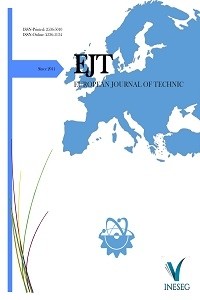Evaluation of Machine Learning Hyperparameters Performance for Mice Protein Expression Data in Different Situations
Evaluation of Machine Learning Hyperparameters Performance for Mice Protein Expression Data in Different Situations
Artificial Neural Networks, Hyperparameter, Machine Learning, Mice Protein, Support Vector Machines,
___
- [1] Gandomi, A., Haider, M., (2015). Beyond the hype: Big data concepts, methods, and analytics. International Journal of Information Management, 35: 137-144.
- [2] Oussous, A., Benjelloun, F.Z., Lahcen, A.A., Belfkih, S., (2018). Big data technologies: A survey. Journal of King Saud University Computer and Information Sciences, 30: 431-448.
- [3] Wang, B., Gong, N. Z. (2018). Stealing hyperparameters in machine learning. IEEE Symposium on Security and Privacy. DOI 10.1109/SP.2018.00038
- [4] Koch, P., Wujek, B., Golovidov, O., Gardner, S. Automated Hyperparameter tuning for effective machine learning. SAS514-2017. SAS Institute Inc. USA. (2017).
- [5] Ser, G., Bati, C. T. (2019). Determining the best model with deep neural networks: Keras application on mushroom data. YYU J. AGR. SCI. 29(3), 406-417.
- [6] Claesen, M., Moor, B.D. (2015). Hyperparameter search in machine learning. The XI Metaheuristics International Conference. arXiv:1502.02127v2 [cs.LG] 6 Apr2015.
- [7] Padierna, L. C., Carpio, M., Rojas, A., Puga, H., Baltazar, R., Fraire, H. (2017). Hyper-parameter tuning for support vector machines by estimation of distribution algorithms. In Nature-Inspired Design of Hybrid Intelligent Systems. 787-800.
- [8] Probst, P., Boulesteix, A. L., Bischl, B. (2019). Tunability: Importance of Hyperparameters of Machine Learning Algorithms. J. Mach. Learn. Res., 20(53), 1-32.
- [9] Hsu, C. W., Chang, C. C., Lin, C. J. (2003). A practical guide to support vector classification. http://www.csie.ntu.edu.tw/∼cjlin/papers/guide/guide.pdf. Date of access: 12.10.2020
- [10] Prevolnik, M., Škorjanc, D., Čandek-Potokar, M., Novič, M. (2011). Application of artificial neural networks in meat production and technology. Computer and Information Science, 11, 223-240.
- [11] Pour Hamidi, S., Mohammadabadi, M. R., Asadi Foozi, M., Nezamabadi-pour, H. (2017). Prediction of breeding values for the milk production trait in Iranian Holstein cows applying artificial neural networks. Journal of Livestock Science and Technologies, 5(2), 53-61.
- [12] Liakos, K., Moustakidis, S. P., Tsiotra, G., Bartzanas, T., Bochtis, D., Parisses, C. (2017). Machine Learning Based Computational Analysis Method for Cattle Lameness Prediction. HAICTA 128-139.
- [13] Bisgin, H., Bera, T., Ding, H., Semey, H. G., Wu, L., Liu, Z., Tong, W. (2018). Comparing SVM and ANN based machine learning methods for species identification of food contaminating beetles. Scientific reports, 8(1), 1-12.
- [14] UCI Database, 2020. https://archive.ics.uci.edu/ml/datasets/Mice+Protein+Expression#
- [15] Higuera C., Gardiner K.J., Cios K.J. (2015) Self-Organizing Feature Maps Identify Proteins Critical to Learning in a Mouse Model of Down Syndrome. PLoS ONE 10(6): e0129126. [Web Link] ournal.pone.0129126
- [16] Frank, E., Mark, A. H., Ian, H. W. The WEKA Workbench. Online Appendix for "Data Mining: Practical Machine Learning Tools and Techniques, Morgan Kaufmann, Fourth Edition, (2016).
- [17] Aydin, C. (2018). Classification of Fire Station Needs Using Machine Learning Algorithms. European Journal of Science and Technology, (14), 169-175.
- [18] Aggarwal, C. C. Neural networks and deep learning. Springer. (2018).
- [19] Haykin, S. Neural networks and learning machines. Pearson Education Canada. (2008).
- [20] Jain, Rasmi. (2017). https://www.hackerearth.com/blog/developers/simple-tutorial-svm-parameter-tuning-python-r/. Date of access: 13.09.2020
- [21] Kavzaoglu, T., Colkesen, I. (2010). Investigation of the effects of kernel functions on the classification of support vector machines and application images. Journal of Map, 144: 73-82.
- [22] Dawson, Carl. (2019). https://towardsdatascience.com/a-guide-to-svm-parameter-tuning-8bfe6b8a452c. Data of access: 04.08.2020
- [23] Igual, L., Seguí, S. In Introduction to Data Science (pp. 1-4). Springer, Cham. (2017).
- [24] Moore, A., 2018. Support vector machines. https://www.autonlab.org/_media/tutorials/svm15.pdf. Date of access: 04.01.2020.
- [25] Guran, A., Uysal, M., Dogrusoz, O., (2014). Effects of support vector machine parameter optimization on sentiment analysis. DEU Faculty of Engineering Journal of Engineering Sciences, 16(48): 86-93.
- [26] Pupale, Rushikesh, https://towardsdatascience.com/https-medium-com-pupalerushikesh-svm-f4b42800e989. Date of access: 11.11.2020
- [27] Van Rijn, J. N., Hutter, F. (2018). Hyperparameter importance across datasets. In Proceedings of the 24th ACM SIGKDD International Conference on Knowledge Discovery & Data Mining (pp. 2367-2376).
- [28] Shaikhina, T., Lowe, D., Daga, S., Briggs, D., Higgins, R., & Khovanova, N. (2015). Machine learning for predictive modelling based on small data in biomedical engineering. IFAC-PapersOnLine, 48(20), 469-474.
- [29] Xu, B., Wang, W., Falzon, G., Kwan, P., Guo, L., Sun, Z., & Li, C. (2020). Livestock classification and counting in quadcopter aerial images using Mask R-CNN. International Journal of Remote Sensing, 1-22.
- ISSN: 2536-5010
- Yayın Aralığı: Yılda 2 Sayı
- Başlangıç: 2011
- Yayıncı: Hibetullah KILIÇ
Investigation of Mechanical And Tribological Properties of Boric Acid Reinforced Composite Plates
Taner AYDIN, Kadir TURAN, Nejat Yıldırım SARI
Comparative Analysis of Lighting Elements’ Effects on Electric System
Sait DURSUN, Ümit TERZİ, Onur AKAR, Temel SÖNMEZOCAK
Demand-Side Energy Management in Smart Buildings: A Case Study
Nazlı HASANOVA, Seçil VARBAK NEŞE
Submodule Based MPPT with Synchronous Buck Converter Under Dynamic Partial Shading Conditions
Medium and Large Vector-Based SVPWM Technique for Five-Phase Two-Level Inverter
Mesut ŞEKER, Mehmet Siraç ÖZERDEM
